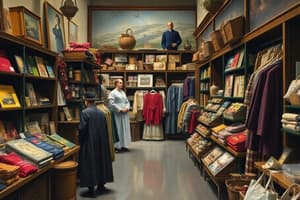Podcast
Questions and Answers
Which of the following best illustrates the 'Wheel of Retailing' concept?
Which of the following best illustrates the 'Wheel of Retailing' concept?
- A luxury retailer introduces a lower-priced private label brand to appeal to a wider range of customers while maintaining its core luxury offerings.
- A discount retailer gradually improves its store design, broadens its product assortment, and increases prices over time. (correct)
- A department store chain consistently offers deep discounts and promotions to attract price-sensitive shoppers.
- A high-end boutique maintains its exclusive product line and premium pricing to cater to its loyal customer base.
A direct-to-consumer brand initially gains popularity through online sales and social media marketing. According to the retail life cycle, what stage is this brand most likely in as it begins to open several brick-and-mortar stores?
A direct-to-consumer brand initially gains popularity through online sales and social media marketing. According to the retail life cycle, what stage is this brand most likely in as it begins to open several brick-and-mortar stores?
- Decline
- Growth (correct)
- Introduction
- Maturity
A retailer specializing in outdoor gear aims to minimize the perceived social risk associated with purchasing their products. Which strategy would be most effective?
A retailer specializing in outdoor gear aims to minimize the perceived social risk associated with purchasing their products. Which strategy would be most effective?
- Offering a generous return policy for all products.
- Featuring endorsements from well-known adventurers and outdoor enthusiasts. (correct)
- Providing detailed product specifications and performance data.
- Implementing a price-matching guarantee to ensure competitive pricing.
Which of the following retailers best exemplifies the concept of a 'destination retailer'?
Which of the following retailers best exemplifies the concept of a 'destination retailer'?
A new online clothing retailer wants to understand its target market better. Which combination of demographic and lifestyle data would be most useful for tailoring its product offerings and marketing messages?
A new online clothing retailer wants to understand its target market better. Which combination of demographic and lifestyle data would be most useful for tailoring its product offerings and marketing messages?
A consumer is heavily influenced by the opinions and preferences of their close friends when making purchasing decisions. Which type of reference group is most influential in this scenario?
A consumer is heavily influenced by the opinions and preferences of their close friends when making purchasing decisions. Which type of reference group is most influential in this scenario?
A subscription box service for organic snacks primarily addresses which characteristic of services retailing to build trust and attract new customers?
A subscription box service for organic snacks primarily addresses which characteristic of services retailing to build trust and attract new customers?
A furniture retailer is developing its retail strategy mix. Which combination of elements would likely result in a strong competitive advantage?
A furniture retailer is developing its retail strategy mix. Which combination of elements would likely result in a strong competitive advantage?
Flashcards
Independent Retailers
Independent Retailers
Retail outlets owned and operated independently.
Destination Retailers
Destination Retailers
Retailers that customers intentionally seek out.
Retail Strategy Mix
Retail Strategy Mix
Balancing product, price, location, promotion, atmosphere, and service to gain an edge.
Wheel of Retailing
Wheel of Retailing
Signup and view all the flashcards
Stages of Retail Life Cycle
Stages of Retail Life Cycle
Signup and view all the flashcards
Lifestyle & Demographic Statistics
Lifestyle & Demographic Statistics
Signup and view all the flashcards
Types of Reference Groups
Types of Reference Groups
Signup and view all the flashcards
Elements of Perceived Risk
Elements of Perceived Risk
Signup and view all the flashcards
Study Notes
- There are several types of ownership.
Types of Ownership
- Independent retailers are privately owned and have operational flexibility with strong customer relationships.
- Chain stores have multiple locations under the same brand and use economies of scale, with standardized processes.
- Franchises are a hybrid of independent and chain models containing established brand names, that require franchise fees.
- Leased departments are stores within a store, like Sephora inside JCPenney.
- Consumer cooperatives are owned by consumers focused on community benefits.
Destination Retailers
- Destination retailers are sought out by customers, rather than being stumbled upon.
- Examples include IKEA, Bass Pro Shops, and Apple Store.
- Destination retailers have unique merchandise, strong branding, and specialized customer experiences.
Retail Strategy Mix
- A retail strategy mix includes the following considerations.
- Merchandise (product).
- Location.
- Pricing strategy.
- Advertising & promotions.
- Store atmosphere & customer service.
- Retailers must balance these elements to create a competitive advantage.
Wheel of Retailing
- Retailers start with low prices and minimal services, then evolve by adding services and increasing prices.
- New competitors emerge at the lower-price level, causing older retailers to adapt or decline.
Stages of the Retail Life Cycle
- Introduction involves high costs and low profits, such as with pop-up shops.
- Growth involves increased sales and competition, such as with direct-to-consumer brands expanding.
- Maturity involves peak sales and price competition, such as with Walmart and Target.
- Decline involves reduced sales, possible reinvention, such as with Kmart and Sears.
Lifestyle & Demographic Statistics
- Demographics include age, income, education, gender, etc.
- Lifestyle includes interests, values, and behaviors influencing shopping habits.
- Retailers use segmentation to target customers effectively.
Types of Reference Groups
- Aspirational groups are those you want to belong to, such as celebrities and influencers.
- Associative groups are those you are in, such as friends and coworkers.
- Dissociative groups are those you avoid, such as opposing political/social groups.
Elements of Perceived Risk & Marketing Solutions
- Functional risk involves a product that will not perform well, which can be solved by offering warranties.
- Financial risk involves something that is too expensive, which can be solved with discounts and financing.
- Social risk involves fear of judgment, which can be solved with brand endorsements.
- Psychological risk involves guilt (e.g., fast fashion), which can be solved with sustainable messaging.
- Physical risk involves safety concerns, which be solved with certifications and safety tests.
Four Characteristics of Services Retailing
- Intangibility means there is no physical product and can be solved with testimonials & reviews.
- Inseparability means that the product is produced & consumed at the same time, emphasize skilled employees.
- Perishability means services can't be stored, using time-sensitive pricing (e.g., airline tickets).
- Variability means service quality fluctuates, solved with staff training, and service guarantees.
Evaluation of Service Retailers
- Reliability means that the service works as expected.
- Responsiveness includes quick problem-solving.
- Assurance involves trust in the provider.
- Empathy involves personalized attention.
- Tangibles are the appearance of facilities.
Gap Model (Fixing Service Issues)
- Knowledge Gap: Business doesn't know customer expectations, fixed by conducting surveys.
- Standards Gap: Poor service guidelines, fixed by improving training.
- Delivery Gap: Employees don't follow guidelines, fixed by using mystery shoppers.
- Communication Gap: Marketing promises more than reality, fixed by aligning advertising with service.
7 Ps of Service Marketing
- Product is the service being offered.
- Price is how much it costs.
- Place is where service is provided.
- Promotion is how the service is marketed.
- People are the employees delivering the service.
- Process is how the service is delivered.
- Physical evidence are the tangible cues like uniforms, store design.
Studying That Suits You
Use AI to generate personalized quizzes and flashcards to suit your learning preferences.




